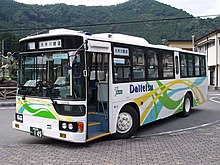Ōigawa Tetsudō
| Ōigawa Tetsudō KK Ōigawa Railway Co.
|
|
|---|---|
| legal form | Corporation |
| founding | March 10, 1925 |
| Seat |
Shimada , Japan |
| Branch | Transport, tourism |
| Website | Ōigawa Tetsudō |
The Ōigawa Tetsudō ( Japanese 大 井 川 鐵道 株式会社 , Ōigawa Tetsudō Kabushiki-gaisha , English Ōigawa Railway Co. ), also called Daitetsu ( 大 鐵 ), is a Japanese railway company . The Shimada- based company operates two rail lines in Shizuoka Prefecture . It is best known for its numerous special trains with historic vehicles.
Companies

In the valley of the Ōi River , the Ōigawa Tetsudō carries traffic on the following railway lines:
- Ōigawa Main Line from Kanaya to Senzu (39.5 km)
- Ikawa Line from Senzu to Ikawa (25.5 km)
Both railway lines use the Cape gauge (1067 mm) as the gauge, but continuous passenger traffic is not possible due to different clearance profiles . In addition to local trains, special trains with historical vehicles run on the Ōigawa main line all year round. On the Ikawa line, the Ōigawa Tetsudō is only responsible for operation, the line is owned by the electricity company Chūbu Denryoku . In addition, the railway company operates the Loco Plaza Railway Museum in Shin-Kanaya station, which presents two steam locomotives and a multiple unit .
Several subsidiaries also belong to the company:
- Daitetsu Advance: Bus service and taxi service in the catchment area of the railway lines
- Kakugawa Daitetsu Taxi: Taxi company in Kakegawa City
- Daitetsu Media Creation
Since 1986 the Ōigawa Tetsudō maintains a partnership with the Alishan Forest Railway in Taiwan . Another partnership has existed since 1997 with the Brienz-Rothorn-Bahn in Switzerland .
history
The railway company was founded on March 10, 1925. It opened the Ōigawa main line in several stages from 1927 to 1931 . This railway line was primarily used to transport wood downhill and to transport building materials and workers uphill to the construction sites of various dams and hydroelectric power stations . On August 1, 1959, the Ōigawa Tetsudō took over the management of the subsequent Ikawa line . This was built by the electricity company Ōigawa Denki or its successor Chūbu Denryoku and completed in 1954.
In 1970, the company decided to purchase a steam locomotive built in 1892 by the British company Dübs and Company in order to prevent it from being scrapped and to keep it in working order. After purchasing a class C56 steam locomotive, the Ōigawa Tetsudō began on July 9, 1976, to carry out regular special trips on the Ōigawa main line. Over the years, more locomotives and passenger cars as well as a turntable from Ransomes & Rapier were added.
The special trips developed into the mainstay of the company and today contribute 90% of sales. Due to the Tōhoku earthquake in 2011 , the number of group travelers fell sharply, which posed financial problems for the company. The offer was reduced and the Meitetsu Group got out as the main shareholder. As a result, the tourism company Eclipse Hidaka took over the majority of the shares on September 1, 2015.
Web links
- Website of Ōigawa Tetsudō (English)
Individual evidence
- ↑ Explore Loco Plaza. Ōigawa Tetsudō, 2019, accessed February 5, 2019 .
- ^ A Japanese Parliamentary Delegation Experiences Alishan Forest Railway. Forestry Bureau Taiwan, November 17, 2016, accessed February 5, 2019 .
- ↑ From the Brienzer Rothorn to the Fujiyama. In: Jungfrau newspaper . June 13, 2007, accessed February 5, 2019 .
- ↑ Akira Shirai: Steam Preservation on the Oigawa Railway. (PDF; 1.6 MB) In: Japan Railway & Transport Review 31. East Japan Railway Cultural Foundation, June 2002, pp. 30–32 , accessed on February 5, 2019 (English).
- ↑ 大 井 川 鉄 道 「地 元 と 協 働」. (No longer available online.) In: Chūnichi Shimbun . September 1, 2015, archived from the original on September 23, 2015 ; Retrieved February 5, 2019 (Japanese).



